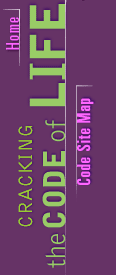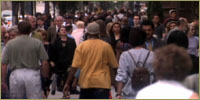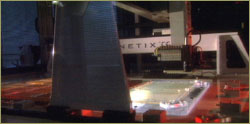
|

|
|

 The news that shocked the world: We have only about
twice as many genes as your average fruit fly.
The news that shocked the world: We have only about
twice as many genes as your average fruit fly.
|
Nature vs Nurture Revisited
by Kevin Davies
The most shocking surprise that emerged from the full
sequence of the human genome earlier this year is that we
are the proud owners of a paltry 30,000 genes -- barely
twice the number of a fruit fly.
After a decade of hype surrounding the Human Genome Project,
punctuated at regular intervals by gaudy headlines
proclaiming the discovery of genes for killer diseases and
complex traits, this unexpected result led some journalists
to a stunning conclusion. The seesaw struggle between our
genes -- nature -- and the environment -- nurture -- had
swung sharply in favor of nurture. "We simply do not have
enough genes for this idea of biological determinism to be
right," asserted Craig Venter, president of Celera Genomics,
one of the two teams that cracked the human genome last
February. [For a conversation with Venter, see
Meet the Decoders.]
Indeed, Venter has wasted little time in playing down the
importance of the genes he has catalogued. He cites the
example of colon cancer, which is often associated with a
defective "colon cancer" gene. Even though some patients
carry this mutated gene in every cell, the cancer only
occurs in the colon because it is triggered by toxins
secreted by bacteria in the gut. Cancer, argues Venter, is
an environmental disease. Strong support for this viewpoint
appeared last year in the
New England Journal of Medicine. Researchers in
Scandinavia studying 45,000 pairs of twins concluded
that cancer is largely caused by environmental rather than
inherited factors, a surprising conclusion after a decade of
headlines touting the discovery of the "breast cancer gene,"
the "colon cancer gene," and many more.
 Notwithstanding the valuable discovery of BRCA1,
the "breast cancer gene," researchers insist the
causes of cancer lie more with nurture than with
nature.
Notwithstanding the valuable discovery of BRCA1,
the "breast cancer gene," researchers insist the
causes of cancer lie more with nurture than with
nature.
|
|
But can the role of heredity really be dismissed so easily?
In fact, the meager tally of human genes is not the affront
to our species' self-esteem as it first appears. More genes
will undoubtedly come to light over the next year or two as
researchers stitch together the final pieces of the human
genome. More importantly, human genes give rise to many
related proteins, each potentially capable of performing a
different function in our bodies. A conservative estimate is
that 30,000 human genes produce ten times as many proteins
in the human body, and figuring out what these proteins do
will be a challenge for a century or more. "This is just
halftime for genetics," says Eric Lander, a leading member
of the public genome project, alluding to decades of work
ahead to unravel the function of all the proteins in the
body. [For a conversation with Lander, see
Meet the Decoders.]
Our snips, ourselves
The key to ultimately defining the respective roles of genes
and environment lies with 'snips' -- genespeak for the sites
littered throughout our DNA that frequently vary between
unrelated people. About three million differences exist in
the genomes of any two unrelated people, but of these only
about 10,000 or so are likely to have any functional
consequences.
|
 Fingering the flaws in their patients' genetic code
will enable doctors of the near future to better
prepare those individuals with high risk for certain
diseases.
Fingering the flaws in their patients' genetic code
will enable doctors of the near future to better
prepare those individuals with high risk for certain
diseases.
|
Scientists have already linked some of these specific DNA
variations with increased risk of common diseases and
conditions, including cancer, asthma, diabetes,
hypertension, and Alzheimer's. Other snips affect the way
people react toward certain drugs. Everyone carries between
five and 50 genetic glitches that might predispose that
person to a serious physical or mental illness. Identifying
these flaws will enable doctors to predict individual
disease risks, recommend suitable lifestyle regimens, and
prescribe the safest and most effective drugs.
But divining DNA variations to uncover health risks will
increasingly threaten our ability to land and hold jobs,
secure insurance, and keep our personal genetic profiles
private. "We're all ultimately unemployable and
uninsurable," warns New York Representative Louise
Slaughter, co-author of a new genetic privacy bill in
Congress, "even the president of a health insurance
company!" Without laws prohibiting genetic discrimination,
she says, society may soon begin penalizing people with
'bad' genes. Even though 22 states have passed genetic
privacy laws, Slaughter believes the confidentiality of your
genetic code should not depend on your zip code. Francis
Collins, director of the public genome project, says "We
don't get to pick our genes, so our genes shouldn't be used
against us." [For a conversation with Collins, see
Meet the Decoders.]
 Ever since the early days of genome sequencing,
scientists have searched for elusive genetic clues
to human behavior.
Ever since the early days of genome sequencing,
scientists have searched for elusive genetic clues
to human behavior.
|
|
Becoming us
While the next few years will undoubtedly see major progress
in rooting out genetic factors that influence our likelihood
of contracting common diseases, what about the role that
genes play in shaping human behavior and personality?
Despite the media hype following recent claims for the
discovery of genes controlling addiction, shyness, thrill
seeking, and most controversially, sexual orientation, in
reality these genes have provided little more than
tantalizing clues to these traits. No one has identified (or
even claimed to have identified) a "gay gene," and the first
few genes associated with other personality traits appear to
have only a minor effect. However, with the full genome
sequence now accessible over the Internet, scientists hope
to pin down many more genes that code for various aspects of
human behavior.
Yet is it realistic to believe that single genes can have a
major impact on behavior? Much attention is currently
focused on the genes that code for proteins involved in the
transmission of electrical signals in the brain. If drugs
such as the antidepressant Prozac work by altering the
activity of neurotransmitters (brain chemicals that convey
messages between nerve cells), it is plausible that
inherited variations in the proteins that produce those
chemicals could exert a dramatic effect on an individual's
mood and temperament. But even the most diehard geneticists
acknowledge that the environment plays a major role in
shaping our behavior, temperament, and intelligence.
With so much attention on explaining behavior in terms
either of nature or nurture, scientists at the
University of California, San Francisco recently described a
fascinating example of how heredity and environment can
interact. Perfect pitch is the ability to recognize the
absolute pitch of a musical tone without any reference note.
People with perfect pitch often have relatives with the same
gift, and recent studies show that perfect pitch is a highly
inherited trait, quite possibly the result of a single gene.
But the studies also demonstrate a requirement for early
musical training (before age six) in order to manifest
perfect pitch. Time will tell whether there is a "perfect
pitch" gene, but it seems reasonable to think that many
personality and behavioral traits will not be exclusively
the province of nature or nurture, but rather an
inextricable combination of both.
|
 Highly sophisticated technology, like this
gene-sequencing machine at Celera Genomics, is
helping to spur advances in molecular medicine.
Highly sophisticated technology, like this
gene-sequencing machine at Celera Genomics, is
helping to spur advances in molecular medicine.
|
Gene genies
Regardless of how many genes are ultimately linked to
disease risk and human behavior, one thing is certain: The
technology to detect and possibly select genes for future
generations is rapidly improving.
In the near future, DNA chips will exist that can detect
thousands of the most significant variations in our DNA. A
decade or two from now, parents of newborn babies may leave
the hospital with a full genome analysis of their offspring
that reveals hundreds of disease-related risk factors and
susceptibilities. And doctors will be able to screen for
more and more traits using in vitro fertilization techniques
such as preimplantation genetic diagnosis (PGD). Doctors
demonstrated the power of PGD last year when the Jack and
Lisa Nash family of Englewood, Colorado selected an embryo
that not only lacked the gene for a fatal genetic disease,
Fanconi anemia, but also provided a bone marrow match for
their dying daughter.
Thus, while Venter is undoubtedly right when he proclaims
that "humans are not hardwired," increasingly we will be
able to fiddle with our genetic wiring such that, in the
complex balance achieved by nature and nurture,
nature gets a little boost.
 Dr. Kevin Davies
Dr. Kevin Davies
|
|
Dr. Kevin Davies is the editor in chief of Cell
Press and the author of
Cracking the Genome: Inside the Race to Unlock
Human DNA
(Free Press, 2001). A graduate of Oxford University,
he holds a doctorate in genetics from the University
of London.
|
Selected sources
Baharloo S., Service S.K., Risch N., Gitschier J., Freimer
N.B. "Familial aggregation of absolute pitch."
American Journal of Human Genetics, September 67,
755-8 (2000).
Grady, D. "Son Conceived To Provide Blood Cells For
Daughter." New York Times, October 4, 2000.
The International Human Genome Sequencing Consortium.
"Initial sequencing and analysis of the human genome."
Nature 409, 860-921 (2001).
Lichtenstein P., Holm N.V., Verkasalo P.K., Iliadou A.,
Kaprio J., Koskenvuo M., Pukkala E., Skytthe A., Hemminki
K. "Environmental and heritable factors in the causation
of cancer -- analyses of cohorts of twins from Sweden,
Denmark, and Finland."
New England Journal Medicine, July 13, 343, 78-85
(2000).
Venter J.C. "A dramatic map that will change the world."
Daily Telegraph February 14, 2001.
Venter J.C. et al. "The sequence of the human genome."
Science 291, 1304-1351 (2001).
Photos: (1-6) WGBH/NOVA; (7) Kathy Blanchard.
Watch the Program Here
|
Our Genetic Future (A Survey)
Manipulating Genes: How Much is Too Much?
|
Understanding Heredity
Explore a Stretch of Code
|
Nature vs Nurture Revisited
Sequence for Yourself
|
Journey into DNA |
Meet the Decoders
Resources
|
Update to Program
|
Teacher's Guide
|
Transcript
Site Map
|
Cracking the Code of Life Home
Editor's Picks
|
Previous Sites
|
Join Us/E-mail
|
TV/Web Schedule
|
About NOVA
Watch NOVAs online
|
Teachers |
Site Map
|
Shop
|
Search |
To Print
PBS Online |
NOVA Online |
WGBH
©
| Updated April 2001
|
|
|